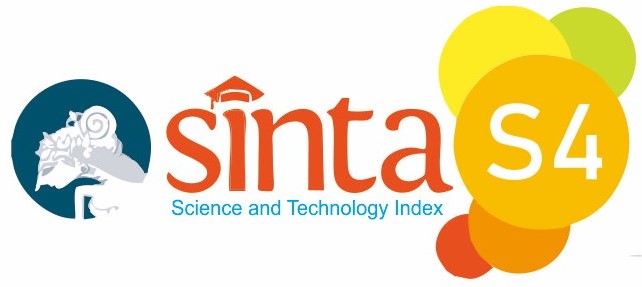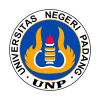PENGEMBANGAN BAHAN AJAR IPA TERPADU DIKOMBINASIKAN DENGAN MODEL ANALOGI : ANALISIS KEBUTUHAN
Abstract
Tujuan dari penelitian ini yaitu merancang bahan ajar yang sesuai karakteristik peserta didik dan diawali dengan analisis kebutuhan peserta didik. Tujuan dari analisis peserta didik ini untuk mengetahui bentuk bahan ajar yang dibutuhkan peserta didik. Jenis penelitian yang dilakukan adalah penelitian dan pengembangan. Subjek penelitian adalah peserta didik kelas V SD 30 Air Dingin Padang. Instrumen yang digunakan berupa angket observasi menggunakan skala likert. Metode yang digunakan metode deskriptif kuantitatif. Penggunaan model pembelajaran IPA terpadu tipe connected, disebabkan karena bahan ajar akan diujicobakan ke SD. Sedangkan pemilihan model pembelajaran analogi, sesuai dengan karakteristik peserta didik yaitu 48% peserta didik sangat setuju belajar IPA dengan contoh yang ada di alam, 32% (setuju), dan 16% (cukup setuju) belajar IPA dengan contoh yang ada di alam. Kemudian 44% (sangat setuju) tertarik belajar IPA dikaitkan dengan kejadian sehari-hari, 32% (setuju), dan 20% (cukup setuju) tertarik belajar IPA dikaitkan dengan kejadian sehari-hari. Diharapkan penelitian ini menjadi pedoman guru dalam mengembangkan bahan ajar.
References
Alp Christ, A., Capon-Sieber, V., Grob, U., & Praetorius, A. K. (2022). Learning processes and their mediating role between teaching quality and student achievement: A systematic review. In Studies in Educational Evaluation (Vol. 75). Elsevier Ltd. https://doi.org/10.1016/j.stueduc.2022.101209
Alyousify, A. L., & Mstafa, R. J. (2022). AR-Assisted Children Book For Smart Teaching And Learning Of Turkish Alphabets. Virtual Reality and Intelligent Hardware, 4(3), 263–277. https://doi.org/10.1016/j.vrih.2022.05.002
Amini, R., & Usmeldi. (2020). The development of teaching materials use an inductive-based 7E learning cycle for elementary school students. Journal of Physics: Conference Series, 1521(4). https://doi.org/10.1088/1742-6596/1521/4/042114
Amini, R., & Usmeldi. (2022). Developing the Interactive e-Module Based on Integrated Learning for Primary School Students. International Journal of Information and Education Technology, 12(4), 272–279. https://doi.org/10.18178/ijiet.2022.12.4.1615
Anggraini, S., & Efendi, N. (2023). Analisis implementasi pemanfaatan lingkungan Sekolah untuk Meningkatkan Motivasi Belajar Siswa pada Pelajaran IPA di Sekolah Dasar. Jurnal Pendidikan Dasar Flobamorata, 4(2), 552–562. https://e-journal.unmuhkupang.ac.id/index.php/jpdf
Baboolal, S. O., & Singaram, V. S. (2024). Implementation and Impact of an Adapted Digital Perioperative Competency-Building Tool to Enhance Teaching, Learning And Feedback in Postgraduate Competency-Based Medical Education. Journal of Surgical Education. https://doi.org/10.1016/j.jsurg.2024.01.015
Borneo, I. (2014). Analogies In High School Classes On Quantum Physics. Elsevier.
Cachay-Gutierrez, A., & Cabanillas-Carbonell, M. (2024). Educational video games to improve the learning process. International Journal of Evaluation and Research in Education (IJERE), 13(3), 1917. https://doi.org/10.11591/ijere.v13i3.26432
Chiu, T. K. F. (2024). Future research recommendations for transforming higher education with generative AI. Computers and Education: Artificial Intelligence, 6. https://doi.org/10.1016/j.caeai.2023.100197
Crilly, N. (2021). The Evolution of “Co-evolution” (Part II): The Biological Analogy, Different Kinds of Co-evolution, and Proposals for Conceptual Expansion. She Ji, 7(3), 333–355. https://doi.org/10.1016/j.sheji.2021.07.004
Daryono, R. W., Ramadhan, M. A., Kholifah, N., Isnantyo, F. D., & Nurtanto, M. (2023). An empirical study to evaluate the student competency of vocational education. International Journal of Evaluation and Research in Education, 12(2), 1079–1086. https://doi.org/10.11591/ijere.v12i2.22805
Ellul, M., & Bezzina, A. (2023). The Effectiveness of Analogy Learning as a Learning Practice Condition in Primary Physical Education. In Malta Journal of Education (Vol. 4, Issue 2).
Flud, J., Acrolu, L., Grden, P., Rpel, A., Sumter, D., & Cooper, C. (2023). Sustnblt n the Future of Desn Educton. The Journal of Design, Economic, and Innovation, 9(2), 158–178.
Fu, L., & Mao, L. (2024). Application of personalized recommendation algorithm based on Sensor networks in Chinese multimedia teaching system. Measurement: Sensors, 33, 101167. https://doi.org/10.1016/j.measen.2024.101167
Gabauer, D., Chatziantoniou, I., & Stenfors, A. (2023). Model-free connectedness measures. Finance Research Letters, 54. https://doi.org/10.1016/j.frl.2023.103804
Glynn, S. M. (2008). Making Science Concepts Meaningful to Students: Teaching With Analogies.
Ilma, S., Al-Muhdhar, M. H. I., Rohman, F., & Sari, M. S. (2022). Promoting students’ metacognitive awareness and cognitive learning outcomes in science education. International Journal of Evaluation and Research in Education, 11(1), 20–30. https://doi.org/10.11591/ijere.v11i1.22083
Irmeilyana, Ngudiantoro, Kholiq Affandi, A., Setiawan, A., & Windusari, Y. (2020). Pemanfaatan Lingkungan Alam Sekitar Sebagai Sumber Belajar dan Media Pembelajaran Matematika, IPA, dan Seni. Jurnal Vokasi, 4(1), 16–23.
Ivanov, D. (2024). Supply chain resilience: Conceptual and formal models drawing from immune system analogy. Omega (United Kingdom), 127. https://doi.org/10.1016/j.omega.2024.103081
Kurniawati, L. (2022). Improving students’ mathematical intuitive thinking ability using analogy learning model. Journal of Physics: Conference Seies, 1–13.
Kwangmuang, P., Jarutkamolpong, S., Sangboonraung, W., & Daungtod, S. (2021). The development of learning innovation to enhance higher order thinking skills for students in Thailand junior high schools. Heliyon, 7(6). https://doi.org/10.1016/j.heliyon.2021.e07309
Lavrenteva, E., & Orland-Barak, L. (2023). Conceptual-analytical framework for exploring culture in EFL coursebooks: Analysis of teaching materials from a multimodal perspective. Social Sciences and Humanities Open, 7(1). https://doi.org/10.1016/j.ssaho.2023.100441
Maghaydah, S., Al-Emran, M., Maheshwari, P., & Al-Sharafi, M. A. (2024). Factors affecting metaverse adoption in education: A systematic review, adoption framework, and future research agenda. In Heliyon (Vol. 10, Issue 7). Elsevier Ltd. https://doi.org/10.1016/j.heliyon.2024.e28602
Maisyaroh, M., Untari, S., Chusniyah, T., Adha, M. A., Prestiadi, D., & Ariyanti, N. S. (2023). Strengthening character education planning based on Pancasila value in the international class program. International Journal of Evaluation and Research in Education, 12(1), 149–156. https://doi.org/10.11591/ijere.v12i1.24161
Mei, L., Feng, X., & Cavallaro, F. (2023). Evaluate and identify the competencies of the future workforce for digital technologies implementation in higher education. Journal of Innovation and Knowledge, 8(4). https://doi.org/10.1016/j.jik.2023.100445
Peedikayil, J. V., Vijayan, V., & Kaliappan, T. (2023). Teachers’ attitude towards education for sustainable development: A descriptive research. International Journal of Evaluation and Research in Education, 12(1), 86–95. https://doi.org/10.11591/ijere.v12i1.23019
Rajabnia, H., Orozovic, O., Williams, K., Lavrinec, A., Ilic, D., Jones, M., & Klinzing, G. (2023). Predictive modelling approach for cottonseed plug velocity applying a circuit theory analogy. Powder Technology, 427. https://doi.org/10.1016/j.powtec.2023.118690
Ribosa, J., & Duran, D. (2022). Do students learn what they teach when generating teaching materials for others? A meta-analysis through the lens of learning by teaching. In Educational Research Review (Vol. 37). Elsevier Ltd. https://doi.org/10.1016/j.edurev.2022.100475
Sabtu, S. H., & Matore, M. E. M. (2024). Systematic literature review on the implementation of the Six Sigma approach in education. International Journal of Evaluation and Research in Education (IJERE), 13(1), 262. https://doi.org/10.11591/ijere.v13i1.26196
Saputra, B. D., Murdino, M., & Tohani, E. (2023). Nationalism education in elementary school: A systematic literature review. In International Journal of Evaluation and Research in Education (Vol. 12, Issue 2, pp. 739–749). Institute of Advanced Engineering and Science. https://doi.org/10.11591/ijere.v12i2.24609
Shabudin, M., Aisyah, A., Darus, S., & Mimiko, N. (2014). Development of Teaching Materials and Utilization of Web 2.0 in Japanese Language Teaching and Learning. Procedia - Social and Behavioral Sciences, 118, 433–441. https://doi.org/10.1016/j.sbspro.2014.02.059
Suciati, I., Idrus, I., Hajerina, H., Taha, N., & Wahyuni, D. S. (2023). Character and moral education based learning in students’ character development. International Journal of Evaluation and Research in Education, 12(3), 1185–1194. https://doi.org/10.11591/ijere.v12i3.25122
Suzuki, S. N., Akimoto, Y., Suzuki, K., Okada, A., Hirata, K., Kato, T., Yajima, K., Kanematsu, H., Fukumoto, T., & Yoshikawa, F. (2020). Development of A-txt system compatible introductory teaching materials for Electric Power Engineering using gaming simulation. Procedia Computer Science, 176, 1557–1566. https://doi.org/10.1016/j.procs.2020.09.167
Tahili, M. H., Tolla, I., Ahmad, M. A., Samad, S., Saman, A., & Pattaufi. (2022). Developing the strategic collaboration model in basic education. International Journal of Evaluation and Research in Education, 11(2), 817–828. https://doi.org/10.11591/ijere.v11i2.21907
Trianto. (2007). Model Pembelajaran Terpadu dalam Teori dan Praktek. Prestasi Pustaka Publisher.
Velarde, C. L., Infantas, M. L. V., Ramos, M. S. G., Carrasco, J. L. T., & Jiménez, J. H. A. (2023). Technology in the educational processes of basic education in Peru. International Journal of Evaluation and Research in Education, 12(1), 433–443. https://doi.org/10.11591/ijere.v12i1.24212
Venkateshvaran, A., Tossavainen, E., Borneteg, C., Oktay Tureli, H., Vanoli, D., Lund, L. H., Flachskampf, F., & Lindqvist, P. (2022). A novel echocardiographic estimate of pulmonary vascular resistance employing the hydraulic analogy to Ohm’s law. IJC Heart and Vasculature, 42. https://doi.org/10.1016/j.ijcha.2022.101121
Yao, R., Zhang, G., Wang, Y., & Bie, R. (2022). Design of Teaching Material Evaluation Incentive Mechanism based on Game Theory. Procedia Computer Science, 202, 47–54. https://doi.org/10.1016/j.procs.2022.04.007
Zhou, W., Guo, K., Ying, Y., & Oubibi, M. (2024). Chinese local music teaching materials: A review from 1934 to 2022. In Social Sciences and Humanities Open (Vol. 9). Elsevier Ltd. https://doi.org/10.1016/j.ssaho.2023.100742
Zulherman, Zain, F. M., & Sailin, S. N. (2023). Factors of using e-learning in higher education and its impact on student learning. International Journal of Evaluation and Research in Education, 12(1), 377–385. https://doi.org/10.11591/ijere.v12i1.23912
Submitted
Copyright (c) 2024 Jurnal Vokasi Mekanika

This work is licensed under a Creative Commons Attribution 4.0 International License.








.svg_.png)


